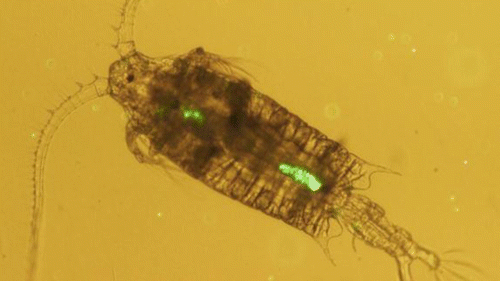Ship-based CO2 flux estimates of the contemporary air-sea flux of CO2 showed that the Southern Ocean (south of 35oS) plays an important role as a significant carbon sink, with a net uptake at the rate of −0.8 ~ −1.0 Pg C/year (Takahashi et al., 2009; Landschützer et al., 2014) largely consistent with climate model-based estimates... Continue Reading →
Increasing river alkalinity slows ocean acidification in river-dominated ocean margins
Although ocean acidification (OA) is mainly driven by the ocean uptake of anthropogenic carbon dioxide from the atmosphere, multiple factors including changes in ocean temperature, biological processes, and river discharge influence its temporal progression. In a new paper accepted in the Geophysical Research Letters, a team of researchers from the Northern Gulf Institute of the... Continue Reading →
Arctic Ocean is experiencing dramatic weight loss due to increasing freshwater storage
The freshwater cycle in the Earth System is a delicate balance between the net loss (i.e., evaporation > precipitation) in the warm tropical-subtropical oceans, the net gain (i.e., precipitation > evaporation) in the cold polar oceans, and the net poleward transport by the atmosphere. These processes maintain the tropical-subtropical oceans salty and the polar oceans... Continue Reading →
You have 1 minute to convince your readers
In this EGU presentation, Wouter Berghuijs shares several key points to improve our paper writing. This presentation should be useful especially for early-career scientists. I particularly like a suggestion to convey only 1 main message in a paper. If you have 10 main messages that are absolutely important and new, it is better to write... Continue Reading →
Zooplanktons eat microplastics? Yes, they do and it may reshape the global ocean-biogeochemistry
Plastics are now widely distributed in the global ocean, serving as a new and serious contaminant for marine ecosystems. For instance, ingestion of small plastic detritus ( 0.1 μm ~ 5 mm), “microplastics” by fish, mussels and seabirds has been widely reported. A recent study (Cole et al., 2013) used fluorescence bioimaging techniques to show... Continue Reading →
Can you speak up freely in group meetings and conferences?
It is very tough especially if you are a student, postdoc or junior scientist to speak up at group meetings and conferences. This has been a constant challenge for me throughout my career. Now, I am a mid-career to senior level scientist. But, I still get nervous (sometimes extremely) when I need to stand up... Continue Reading →
Thermohaline Meridional Overturning Circulation on Enceladus
Enceladus is a miniature-size Saturn's moon (Earth's moon is about 7 times larger) known to have a deep ocean (~ 40km) beneath the thick icy crust (~20km). It has been suggested that Enceladus’s interior ocean is heated from below through hydrothermal activity, powered by tidal dissipation. The ocean should in turn carry the heat to... Continue Reading →
Unmanned Seagliders could be used to explore Titan’s sea of liquid methane
Titan is the largest moon of Saturn and receives only about 1% of the amount of solar energy Earth does. Thus, the average surface temperature is extremely low, about 90.6 K (-182.55 °C, or -296.59 °F). Under this extremely cold temperature, Titan's atmosphere is nearly free of water vapor, and is primarily composed of nitrogen and methane. At the... Continue Reading →
A Seasonal Probabilistic Outlook for Tornadoes (SPOTter) in the Contiguous U.S.
This new study accepted in Monthly Weather Review (Lee et al., 2021) presents an experimental model for Seasonal Probabilistic Outlook for Tornadoes (SPOTter) in the contiguous U.S. for March, April and May, and evaluates its forecast skill. This forecast model uses the leading empirical orthogonal function modes of regional variability in tornadic environmental parameters (i.e.,... Continue Reading →









